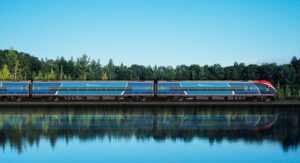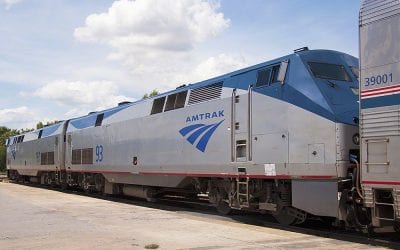To maximize overall Amtrak safety, the US national passenger railroad should first deploy its new Airo trainsets to the Northeast Corridor to replace their oldest trains, manufactured prior to modern rail safety standards.

Airo passenger cars are integrated with their locomotives, making them true trainsets. The trainsets will have many features that have been nothing but wish lists for far too long.
Airo trainsets have a great passenger feature set, but most important is their significantly increased safety compared to the NEC’s rolling stock.
As a frequent Amtrak rider on the Keystone Service route, while I’m looking forward to the Airo’s spaciousness, new interior features, somewhat faster speed and green impact, what’s most important to me is their substantially improved safety, compared to Amtrak’s current NEC rolling stock.
That’s partly why I’m so disappointed at Amtrak’s decision to deploy the Airo to their Cascades route first. The Cascades trains are just ten years old, built to today’s safety standards. Those standards didn’t exist when the NEC fleet was built. The cars on the Cascade’s tracks are trainsets, not individual cars hooked together. Trainsets have significant safety advantages.
I believe the Airo cars should be deployed to the NEC first because they will have a significantly larger safety impact than elsewhere in the Amtrak system.
To understand why Airo trainsets should be deployed in the NEC first, we must examine passenger load, fleet age, and trainset safety.
To understand why Amtrak’s Airo trainsets should be deployed to the NEC ahead of any other deployment, let’s examine passenger load, fleet age, safety standards and trainset advantages.
In 2021, the last year of full annual statistics for Amtrak, ridership approached pre-pandemic levels, hitting about 22.9 million passengers. NEC ridership returned to close to pre-pandemic levels of 9.2 million passengers, about 40 percent of Amtrak’s total ridership. That contrasts with the Cascades’ service, which carried less than 400,000 passengers, less than two percent of Amtrak’s passengers. I submit that if safety is truly the most crucial consideration, then Amtrak needs to rethink its Airo deployment order.
Amtrak’s NEC fleet of 610 passenger cars was all built more than four decades ago.
In the NEC, Amtrak has 138 Amfleet II cars built by the defunct Budd Company in 1981. They also have 457 Amfleet I cars built by Budd in 1975. They’ve even got 15 Metroliner leftovers that are sometimes used on the Keystone Service, Hartford Line, and Valley Flyer. They were built in 1967 while Lyndon B. Johnson was President of the United States.
The Cascades route uses Siemens Charger Talgo Series 8 Horizon trainsets, built in 2013, having retired the older Talgo Series VI trainsets.
Quickly doing the math, Amfleet II cars are over 30 years older than the Talgo Series 8 trainsets.
The 2015 Amtrak crash on the “Frankford Junction Curve” showed how badly Amtrak needs to upgrade its NEC fleet sooner than later.
When we look at the safety of the current Cascades’ versus NEC trains, it’s impossible to not look back to the terrible Amtrak accident in 2015 that occurred on the infamous “Frankford Junction Curve.”
The cause of the wreck on May 12, 2015, was not the train cars themselves or its locomotive. The National Transportation Safety Board (NTSB) report indicates that the train derailed because it entered the “Curve” at 106 mph, 56 mph higher than its speed limit of 50 mph.
From the NTSB:
“As the train entered the curve, the locomotive engineer applied the emergency brakes. Seconds later, the train — one locomotive and seven passenger cars — derailed. There were 245 passengers, 5 on-duty Amtrak employees, and 3 off-duty Amtrak employees on board. Eight passengers were killed, and 185 others were transported to area hospitals.”
According to the NTSB, the train’s engineer lost “situational awareness” of where he was and therefore failed to slow the train to no more than 50 mph. They noted that the accident still could have been avoided if “Positive Train Control” (PTC) had been in place to enforce the Curve’s speed restriction. While the other side of the curve had Amtrak’s version of PTC, called “Automatic Train Control” (ATC), it wasn’t until after the deadly crash that it was installed on both sides.
While the age and manufacturing standards of the train cars didn’t cause the 2015 crash, they significantly contributed to the seriousness and number of injuries that occurred.
The NTSB found other problems during its accident investigation of the 2015 crash. They found that if the passenger car windows had remained intact and secured in the cars, some passengers would not have been ejected and would likely have survived the accident. In addition, they found that the passengers were not protected from severe injuries resulting from being thrown from their seats when the cars overturned.
The NTSB explained that passengers experienced “complex forward and lateral motions and forces during the accident.” The current safety requirements for passenger railroad equipment include standards intended to minimize the effects of collision crash forces by “trying to ensure that occupant space is preserved (structural crashworthiness) and that interior fittings such as seats remain secure (interior crashworthiness).”
The NEC train cars were built before the US implemented safety standards for their manufacture.
Here’s the continuing problem for passengers in the NEC. Passenger equipment safety regulations didn’t exist before 1999. Since then, there has been real progress in passenger train car design, but the Amtrak passenger trains in the NEC were all manufactured before 1982, almost two decades before any standards were set. On the other hand, trainsets running on the Cascades’ route are only ten years old and built to comply with the standards.
The NTSB also reported that even if Train 188 cars had been manufactured to current standards, the passengers still wouldn’t have been protected from the lateral forces caused by the derailment and overturn. The NTSB concluded that, “the current requirements are not adequate to ensure that occupants are protected in some types of accidents.”
The new Airo trains are built as trainsets, not individual cars, making them much safer.
The trains that Airo will replace were built as separate train cars, but Airo locomotives and cars are designed and built as one unit. That design reduces the risk of tipping and overturning, limiting lateral forces and movement and making them safer for passengers.
Taking into account the number of passengers Amtrak carries in the NEC versus the Cascades, the age of the cars in each, the standards under which they were manufactured, and that the trains in the NEC were manufactured as individual cars versus the Airos built as trainsets, I call upon Amtrak to change the Airo deployment. Send the Airo trains to the NEC first until their NEC launch is complete.
After many years working in corporate America as a chemical engineer, executive and eventually CFO of a multinational manufacturer, Ned founded a tech consulting company and later restarted NSL Photography, his photography business. Before entering the corporate world, Ned worked as a Public Health Engineer for the Philadelphia Department of Public Health. As a well known corporate, travel and wildlife photographer, Ned travels the world writing about travel and photography, as well as running photography workshops, seminars and photowalks. Visit Ned’s Photography Blog and Galleries.

